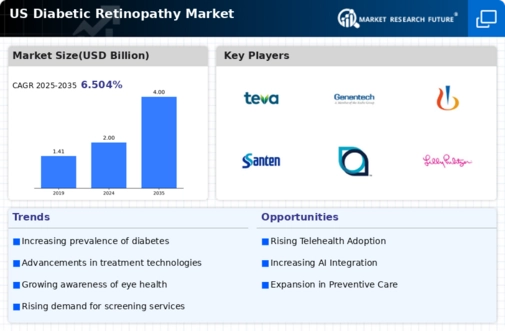The US Diabetic Retinopathy Market has grown significantly in recent years, driven by the increasing prevalence of diabetes and the resulting demand for effective treatment options. This market encompasses a variety of therapeutic solutions, including pharmaceuticals and surgical interventions, aimed at addressing the vision complications associated with diabetic retinopathy. The competitive landscape is characterized by the presence of numerous players, each contributing to innovations in diagnostics, treatment modalities, and technologies that enhance patient outcomes.
The landscape is influenced not only by established pharmaceutical giants but also by emerging biotechnology companies focusing on niche markets within the diabetic retinopathy space. As competition intensifies, companies are emphasizing product differentiation, establishing strategic partnerships, and investing in research to ensure a foothold in this lucrative market.
Teva Pharmaceutical Industries has carved out a notable position within the US Diabetic Retinopathy Market through its extensive portfolio and commitment to accessibility. The company's strengths lie in its comprehensive range of generic and specialty medications, providing affordable treatment alternatives to patients. Teva is recognized for its focus on research and development, allowing it to adapt and expand its treatment options in response to evolving market needs.
Furthermore, its established distribution channels ensure broad market reach, facilitating easier access to its products for healthcare providers and patients alike. Teva's operational efficiencies and focus on cost management help maintain competitive pricing, which is crucial in the context of a market where affordability is a significant factor in treatment selection.
Genentech, a leader in the US Diabetic Retinopathy Market, is renowned for its innovative biotechnology solutions, particularly in developing novel therapies aimed at preventing vision loss in diabetic patients. The company's flagship products include anti-VEGF agents that have transformed the treatment landscape for diabetic retinopathy, providing effective options that enhance visual acuity and slow disease progression. Genentech's robust presence in the market is underpinned by a strong R&D pipeline, consistently delivering groundbreaking advancements that address unmet medical needs.
The company has also engaged in strategic partnerships and collaborations with academic institutions and other firms to expand its product offerings and accelerate clinical development. Mergers and acquisitions have played a key role in strengthening Genentech's market position, enabling the integration of diversified therapeutic capabilities. The company’s commitment to patient support programs further reinforces its standing in the US, making it a trusted name among healthcare professionals and patients navigating the challenges posed by diabetic retinopathy.





















